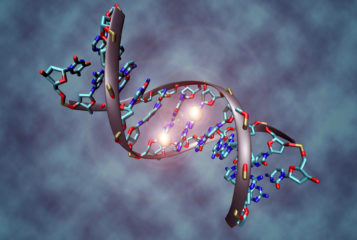Researchers have discovered the mechanism that links variations in the so-called 'obesity gene' FTO to weight gain.
The study reveals that certain variants in the FTO gene make a person's adipose cells less likely to become the type that burn energy, and more likely to be the type that store it as fat.
It was previously thought the gene was linked to obesity through effects on the brain relating to appetite and propensity to exercise. But the researchers found that the variants in fact amplify the activity of two other genes - IRX3 and IRX5 — which are involved in determining what type of fat cells are produced.
The increased expression of IRX3 and IRX5 in developing fat cells (pre-adipocytes) makes them less likely to develop into energy-burning beige cells, and more likely to turn into lipid-storing white fat cells.
'There's a dogma that it all depends on appetite and exercise. That it's your choice, and everything is decided by your brain,' co-lead author Professor Manolis Kellis from Harvard University told New Scientist . 'We're showing that your fat cells have a very strong role in all this, independent of the brain.'
The team first used epigenetic data from the Roadmap Epigenomics Project which pinpointed FTO activity in developing fat cells called pre-adipocytes.
They then extracted pre-adipocyte cells from a group of 100 Europeans, half of whom carried obesity-associated risk variants, and half who didn't, and measured their gene expression. They found that those with the obesity risk version had less expression of genes to do with energy consumption and more to do with lipid storage.
The researchers used the increasingly popular genetic editing CRISPR/Cas9 technology to either change the risk-variant into the 'healthy' variant in cells from participants with risk variants, or vice versa.
Changing the DNA of cells from people without the risk variants to match the risk-associated sequence at this one site caused more IRX3 and IRX5 to be expressed, and the cells to behave like those from the risk-allele carriers, and store more fat.
Conversely, changing this site in cells from risk-allele carriers to the non-risk-associated version caused less IRX protein to be made, leading the cells to undergo more thermogenesis and less lipid storage.
The researchers also bred mice that lacked a functioning copy of the IRX3 gene. These mice were smaller than mice that had proper IRX3 genes, used more energy and put on less fat (even on a high-fat diet), despite eating and moving around the same amount.
The FTO gene has repeatedly been identified in genome wide association studies as the most significant genetic location to associate with obesity and higher body mass index scores. Around 44 percent of Europeans carry a variant of the gene that raises their risk of obesity by 30 percent. However, it was unclear exactly how they might influence a person's physiology.
Dr Myrte Merkestein, a researcher from the University of Oxford who was not involved with this research, told New Scientist: 'What this work shows very elegantly is that a key risk-FTO variant acts by limiting the development of beige fat cells.'
However, she added, 'Whether these findings will lead to new therapies for obesity is less certain, because it's likely the switch between beige and white fat cells is set during development of the embryo, and therefore it may already be too late to intervene in adulthood'.





Leave a Reply
You must be logged in to post a comment.